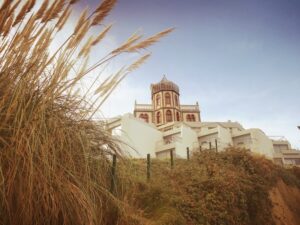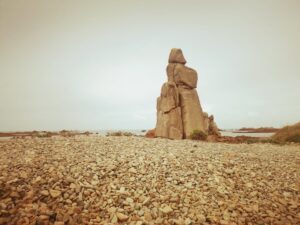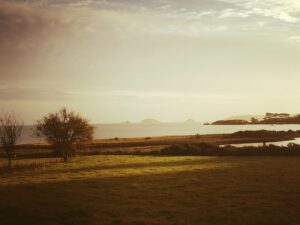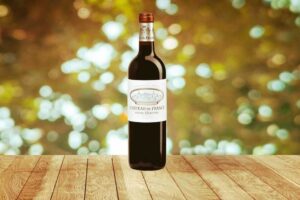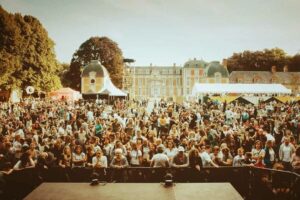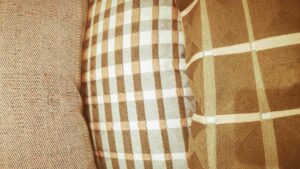The Creuse is told through the Fresque de Bridiers, the Scenovision and its Arboretum Sédelle
6 min read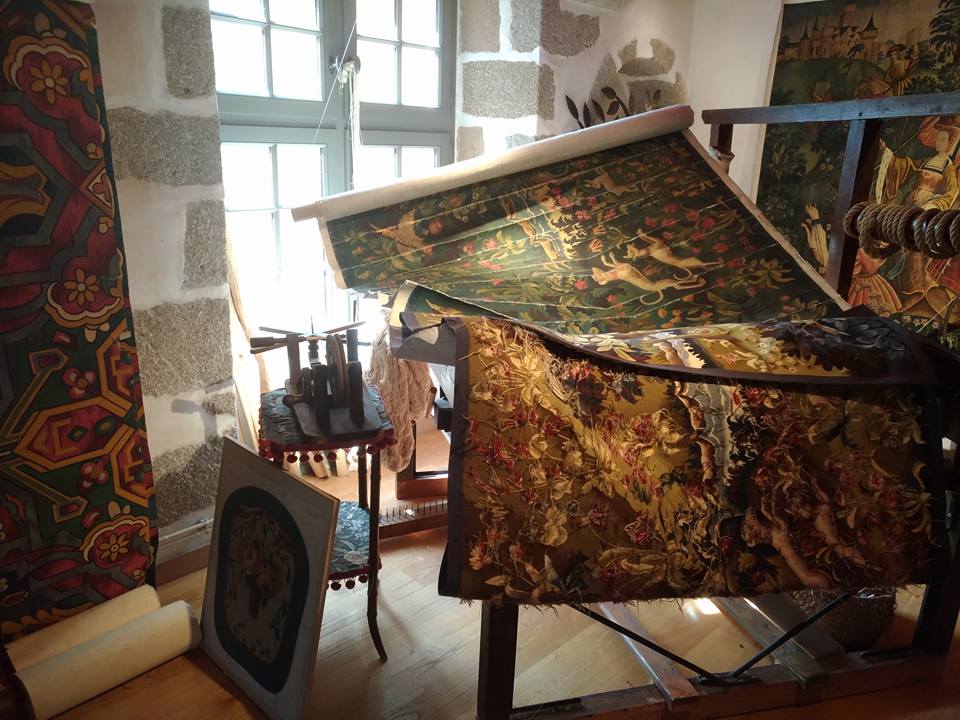
La Souterraine, a thousand-year-old city, a stage for Saint-Jacques-de-Compostelle.
Visiting the crypt of the Notre-Dame de La Souterraine church (built in 2 centuries, from the novel to the early Gothic), we can see what could probably be part of the remains of one of the first Christian churches in France, dating from the 5th century, probably because of the proximity of the Galloromaine city to Bridiers.


Archaeological excavations are taking place right now to try to continue to unravel the mystery. Visiting the 3 chapels of the crypt, we can see a wall composed of occuli, thus serving as a sound transmission from the nave. What is not the first surprise of the site since the porch is of Mozarabic style as many places of worship on the road to Santiago de Compostela (Photo credits: Alexandre Plateaux).


A temporary exhibition occupies the crypt, instead of an old Gallo-Roman necropolis that would have been Christianized during the High Middle Ages. A small building built of wood frame would have been built. It is easy to imagine that it was this place that Gérard de Crozant gave to the Saint-Martial abbey of Limoges in the year 1015. Enlarged by three chapels, the original building served as a base for the construction of the abbey (Photo credits: Alexandre Plateaux).


Exterior view of the Notre-Dame de La Souterraine church (Photo credits: Alexandre Plateaux).


Many regional saints are represented on the stained glass windows including Saint Martial, evangelizer of the Limousin of the 3rd century and supposedly 13th apostle according to the chronicler of the Middle Ages, Adémar de Chabannes and several intact Ex-Voto (Photo credits: Alexandre Plateaux).
The town of La Souterraine celebrates its millennium through the monumental historical Fresque de Bridiers
In the heart of a territory steeped in history, is perpetuated for the 12th edition, this year, of a major annual event, the Fresco of Bridiers.
Like the Puy du Fou, but retracing a different historical theme for each edition, in the form of cinéscenie and in a gigantic open-air theater with sound and light, HD music, giant images, special effects, pyrotechnics, hitches, cavalry…
This performance has steadily improved over the years both technically and in terms of the involvement of local volunteers as extras of this project that takes dimensions outside standards.


Numbering 400 this year and coming from nearly 40 associations of different know-how, these volunteers endorse the customs and customs of the time to live on the whole of the 5-hectare wide stage (Photo Credits: Estelle Goix).


A village of medieval artists allowed to introduce the spectators to the traditional techniques of period (Photo Credits: Alexandre Plateaux).

Sponsored by the singer Fabienne Thiebault who gives his voice to narrate the first steps of the constitution of this millennial city. The staging requires a gigantic preparatory work spanning several months and 5000 hours, so that the scenery of this ephemeral scene can marry the slopes of the panorama of this natural scene offered by the Tower of Bridiers, as if it had been built in time to host such an event that gives pride to multiple plans spread around the site, and this in order to best meet this demanding pageant.
 Located on a mound surrounded by marshy land, the tower of Bridiers seems to date from the end of the 12th century. Former fortified seat of the viscount of Bridiers, in the thirteenth century, the site is unoccupied and abandoned for nearly two centuries (the fifteenth and sixteenth centuries) and then undergoes many degradations. Listed as a Historic Monument since 1968, the first consolidation work of the tower was undertaken in 1982 and is followed by excavation work.
Located on a mound surrounded by marshy land, the tower of Bridiers seems to date from the end of the 12th century. Former fortified seat of the viscount of Bridiers, in the thirteenth century, the site is unoccupied and abandoned for nearly two centuries (the fifteenth and sixteenth centuries) and then undergoes many degradations. Listed as a Historic Monument since 1968, the first consolidation work of the tower was undertaken in 1982 and is followed by excavation work.
Thus this fresco is based on a fiction by the young Albéric, in 1017, abandoned child, entrusted to the age of 10 years to the monks of St Martial in Limoges. He learns to read, to write, to count and reveals himself very quickly as a brilliant student … who quickly withdraws himself from the monastic life for which he is destined. His will is to become a builder. From his talent and the quest in his art will emerge the work that will be that of a lifetime: the church of Notre-Dame de La Souterraine and the first stones.
The sound and light show 2017 of the Bridiers Historical Fresco, this year entitled “The Blood and the Stone”, retraces the epic born of this vocation and the quest for knowledge, Albéric’s initiatory journey from his limousine abbey to door of Jerusalem … in a moving story whose outcome will be on his deathbed.


Thus we find among others towers, a chapel, medieval ramparts, swamps or a Viking drakkar (Photo credits: Alex Plato).


Permanent stands allow to welcome nearly 2000 spectators each evening as well as for other events(Photo credits: Alex Plato).
The Scenenovision of Benevent brings you back to the daily life of the Creusois of the last century

An eleventh year promises to be rich in visitors for the Scenovision, which will welcome nearly 9000 curious for this place full of Creusoise history, in particular the daily life of families who most of them sent at least one mason to opt for a more fertile ground for an officer .
The Benevent site traces this rural and economic exodus, sometimes forced at the end of the 19th century, and their drastic working conditions, particularly in the capital.


Through an interactive journey that takes the visitor independently and plunges him into a historical staging via sequences viewable in 7 different rooms with a concern for technological rendering including a 3D movie, several reenactments (retail close) of places of life like this distillery of this digestive local Benevento, or even a typically Creuse cafe where we feel the old-fashioned atmosphere of old wood furniture and wall coverings.
The visitor feels transported in a romanticized yet realistic universe around this experience of lives of workers, notables and their families via animated sequences never stingy with surprises (Photo credits: Alex Plato).

The Arboretum of Sédelle continues the world’s plant heritage
 Riveted on the banks of the Sédelle, the Arboretum of Sédelle created by the landscape architect Philippe Wanty proposes visits to discover its unique collection of 500 species of deciduous trees, constituted since 1978.
Riveted on the banks of the Sédelle, the Arboretum of Sédelle created by the landscape architect Philippe Wanty proposes visits to discover its unique collection of 500 species of deciduous trees, constituted since 1978.
This former student of the famous landscape gardener Gilles Clément, also based in Creuse and quoted formerly that “this country is a garden”, opens to the public its unique place.
This magic site is dedicated to the protection of rare and protected species since it was labeled by the CCVS (Conservatory of Specialized Plant Collections), for its action to preserve maples, for instance.
Indeed, we can find 110 different species on the site and some of which are endangered, as opposite this species with Japanese bark tawny cinnamon maple (Acer Griseum) (Photo credits: Alex Plato).


The visit continues via a park with a vertical drop of 40 meters, composed of a very bucolic old fishing basin, works of “Land Art”, many massifs of high-colored species such as azaleas, rhododendrons and other hydrangeas (Photo credits: Alex Plato).


By extending the descent to the banks of the Sédelle river and its prominent rocks dominated by a virgin heather, a thousand colors, worthy of a landscape that could inspire painters of the Creuse Valley (Photo credits: Alex Plato).


5000 visitors meet each year, also around plant and cultural encounters, including the upcoming performance of a concert by cellist Vincent Segal, in the kiosk made of authentic chestnut wood.
A place of vegetable tourism on a human scale, as it surrounds the vernacular house of the designer, including local materials made of granite and chestnut shingles.
We can be sure that many other surprises will grow on its 16 hectares of land including 8 hectares dedicated to the arboretum (Photo credits: Alex Plato).
The Gallery Atelier 48 offers a contemporary view of local art


A stone’s throw from La Souterraine, located in the commune of Dun Le Palestel, the Gallery Atelier 48 offers a workshop space for artists and exhibition made of porcelain and local paintings… (Photo credits: Alex Plato).


… all in a frame with colors inspired by the Hispanic origins of the hostess Yasmine (Photo credits: Alex Plato).




In a village tinted with centuries-old buildings, such as this Hotel Joly and Creusoise gastronomy, including this official dessert with hazelnuts said “Le Creusois” (Photo credits: Alex Plato).
More information on: www.tourisme-creuse.com


